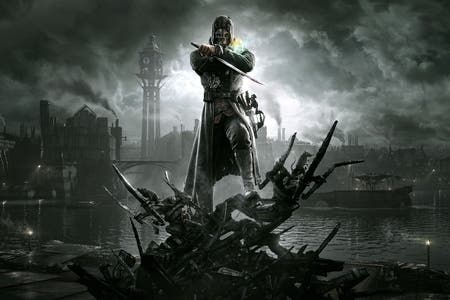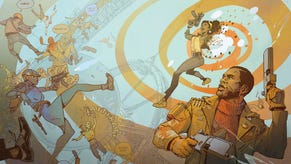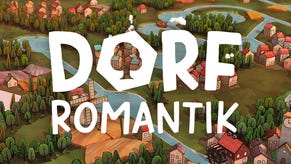Dishonored review
Best served cold: The original and all DLC reviews, to mark the GOTY Edition's release.
Dishonored: Game of the Year Edition is released in Europe today, and it includes all of the game's download expansions. To mark the occasion, we're republishing our review of the game - originally published on 8th October 2012 - below. Also, down the left-hand column, you'll find links to all our reviews of Dishonored DLC, and a few of our other favourite articles about the game.
When was the last time a game asked you to wait? Not just wait for a loading screen or pause for a few seconds to line up the perfect sniper shot. Real waiting. Patience. The ability to sit, immersed in a game world for minutes at a time, watching, plotting and planning.
There's a lot of waiting in Dishonored. You'll peer through keyholes as the seconds tick past, wary of pressing on until you're absolutely sure there's nobody on the other side. You'll squat behind walls and ruins, using supernatural abilities to follow the sickly yellow outlines of your foes, making mental notes until you've spotted the gap in their movements that might let you slip through undetected. You'll cower, low on health, as the thundering footsteps of mechanical stilt-walking Tall Boys stomp past, praying they don't spot you. In Arkane's dark and delicious tribute to hardcore stealth gaming, patience is most definitely a virtue.
Or you can run around, stabbing people in the neck or shooting them in the face. Your choice. In Dishonored's elastic world, there are no overt reasons not to be a violent maniac. No morality metre and no good or bad choices. As disgraced Royal bodyguard Corvo - framed for the assassination of the Empress of a plague-stricken waterfront empire - it's really up to you how you go about aiding a small Loyalist resistance in restoring order to the city of Dunwall, even if you end up leading it into chaos in the process.
What's most noticeable is how narrow Dishonored is. This is a ruthlessly focused game with no interest in the sort of meandering bloat that has crept into blockbusters as this hardware generation stretches out its twilight for another 12 months. There are no naval battles, no gimmicky co-op modes, no gameplay hubs to decorate and upgrade. There's just you, a small selection of gadgets and abilities, and levels that are true sandboxes: small, self-contained areas rich in possibilities.
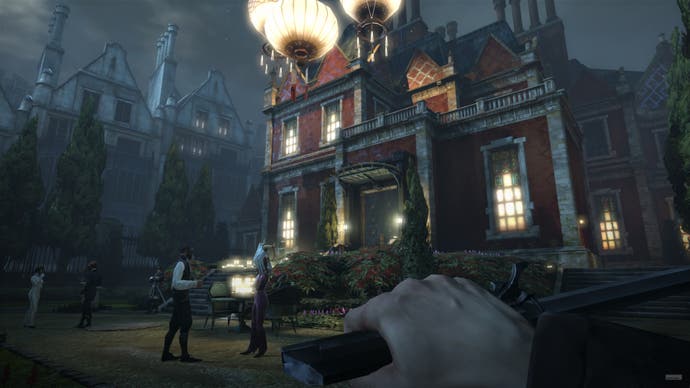
There are just six active powers in the game and four passive ones. Each can be upgraded only once using secret runes found during your missions. Your weapons have a little more room to evolve, but even these are kept tightly controlled. Blueprints will allow your Tesla-esque scientist ally to create new gizmos, but the number barely scrapes into double figures. It's all about fully mastering the tools you have rather than constantly looking out for the next toy to play with.
So you'll teleport across short distances, use your sinister mask to eavesdrop on enemies like a steampunk Batman, or possess animals and humans in order to access places Corvo cannot reach. Rats, in particular, are a recurring motif - both friend and foe in your quest for revenge. Possessing them allows you to scurry through vents and pipes, circumnavigating high-tech security. In large numbers they'll even devour any dead bodies, helping to cover your tracks. Of course, they'll also try to eat you - unless you equip the "bone charm" power-up, one of 40 hidden throughout the game, that will keep them at bay.
Despite its microscopic focus on a level-by-level basis, this is a world to lose yourself in, drawing heavily on visual design director Viktor Antonov's experience on Valve's seminal Half-Life 2. Dunwall's elegant decay is familiar from Gordon Freeman's journey through City 17, as is the thin diffused sunlight that makes the soaring architecture look as defeated and washed-out as its inhabitants. There are even stronger reflections in the eerily masked City Watch guards and their angular blockades, so visually reminiscent of the Combine that it can't be an accident.

But then, Dishonored is not a game much concerned with originality. You can pick and choose from an array of influences that it all but wears on its sleeve. From co-creative director Harvey Smith there's a clear line back to the original Deus Ex, with its emphasis on allowing the player to choose between stealth and guile or bold assault on a moment-by-moment basis. The dual-wiedling, magic-and-melee first-person combat suggests The Elder Scrolls, but has deeper roots in Arkane Studio's Arx Fatalis and Dark Messiah. The methodical pace harks back to Thief, while the option to murder or incapacitate your primary targets in a variety of opportunistic ways comes direct from Hitman. Even the way side stories are told through audio logs, books and notes suggests Arkane Studios absorbed some of Rapture's ambience while assisting on BioShock 2.
It's deceptively easy to reduce the game to a laundry list of obvious influences, but if a game is going to draw from its peers, you'd be hard pushed to come up with a better list than that. Crucially, Dishonored folds these inherited and inspired-by systems into a world that is very much its own, where Dickensian squalor rubs up against the ruthless intrigue of a Tudor court in a city financed by whale oil and whiskey and overrun with rats.
It's a game where the larger story being told ultimately takes a back seat to the unique stories you'll create in each level: those impossible escapes or uplifting flukes that stick in the memory long after you've forgotten the cut-scene drama of who did what and when. The game is at its strongest in the early stages, where the core plot informs a run of brilliantly inventive and distinctive missions.

You'll infiltrate a gaudy high class brothel, looking for ways to bump off two sadistic brothers. You'll mingle with guests at a decadent masked ball. Even the optional objectives are memorable in these locations: torture a perverted art dealer, or take part in a pistol duel with a snooty aristocrat. In such moments, every aspect of Dishonored pulls in the same direction and the result is invigorating, immersive and thoroughly satisfying
Sadly, such a fine balance doesn't last, and following a fairly predictable plot twist the game ditches the weird and colourful backdrops in favour of grey stone and steel as you creep through a generic enemy fortress on your way to a rather abrupt conclusion.
It's a seriously tough game too, especially if you're trying to be as stealthy as possible. Combat is tricky enough that open confrontation is a bad choice, but there are scenarios where simply travelling 50 metres becomes a task of herculean proportions as you inch ahead, dutifully saving every time you advance a decent distance without making some calamitous error. Although there are only nine missions, each contains multiple interlinked areas and, for those trying to maximise their stealth, it's entirely possible for one mission to take several hours to complete.
Certainly, the achievements for completing levels, and even the entire game, without being spotted or killing anyone will come with hardcore bragging rights. That the game can pose such an imposing stealth challenge, yet still accommodate players who muff it up, is deeply impressive.
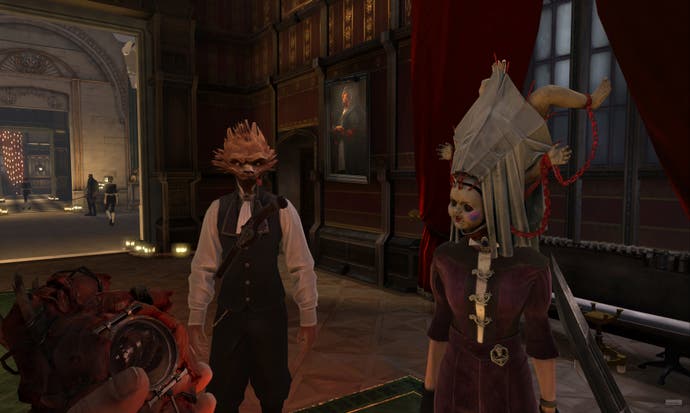
It's a shame, then, that the mechanics of the game aren't always up to the high standard set elsewhere. Context-sensitive actions are needlessly fussy, as opening doors or teleporting to ledges requires a little too much shuffling around for the right prompt to appear. Frustrating and, under pressure, sometimes fatal.
The AI of your opponents doesn't always hold up to scrutiny either, with guards sometimes spotting you from a long distance and other times remaining blissfully unaware of the black-clad figure crouching in their peripheral vision. Once alerted to your presence, their only instinct is to mob you, and should you evade them by ducking through a doorway, they won't think to check if you close the door behind you. On one occasion I actually had guards appear behind me in a room with only one exit, and it's common for bodies and thrown objects to lodge, juddering and twitching, in walls and floors.
It's disappointing, too, that after completing the game there's no way to go back and reattempt earlier missions with all the abilities and gadgets you've unlocked. You can replay any level you want, but only with the abilities you had at that point in the game. With no way to respec your character, you'll need to start over completely in order to try all the different approaches, as well as to see the impact of the chaos system that changes the game world according to your play-style (a system that struggles to make its presence felt in a single play-through). In this context the lack of a New Game + option, such a perfect fit for games of this type, seems all the more of an omission.
Such oversights are easily forgiven when stacked up against Arkane's broader achievements, but they can't help but take the shine off an otherwise impeccably polished experience. And that, ultimately, is what you'll take away from time spent in Dishonored's ominous embrace.
This is a muscular and confident game, one with the utmost faith in its own fiction and a dedication to gameplay satisfaction at a microscopic level, paid off in dozens of situations that feel completely random and organic, even when they've clearly been planted there for you to find. Tighter control and a more generous approach to replay value would elevate Dishonored to true classic status, but it stands as one of the year's best all the same.
